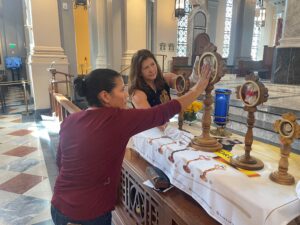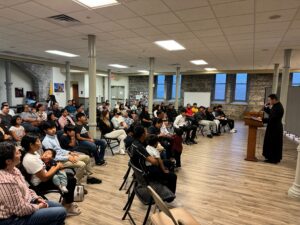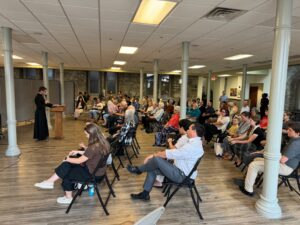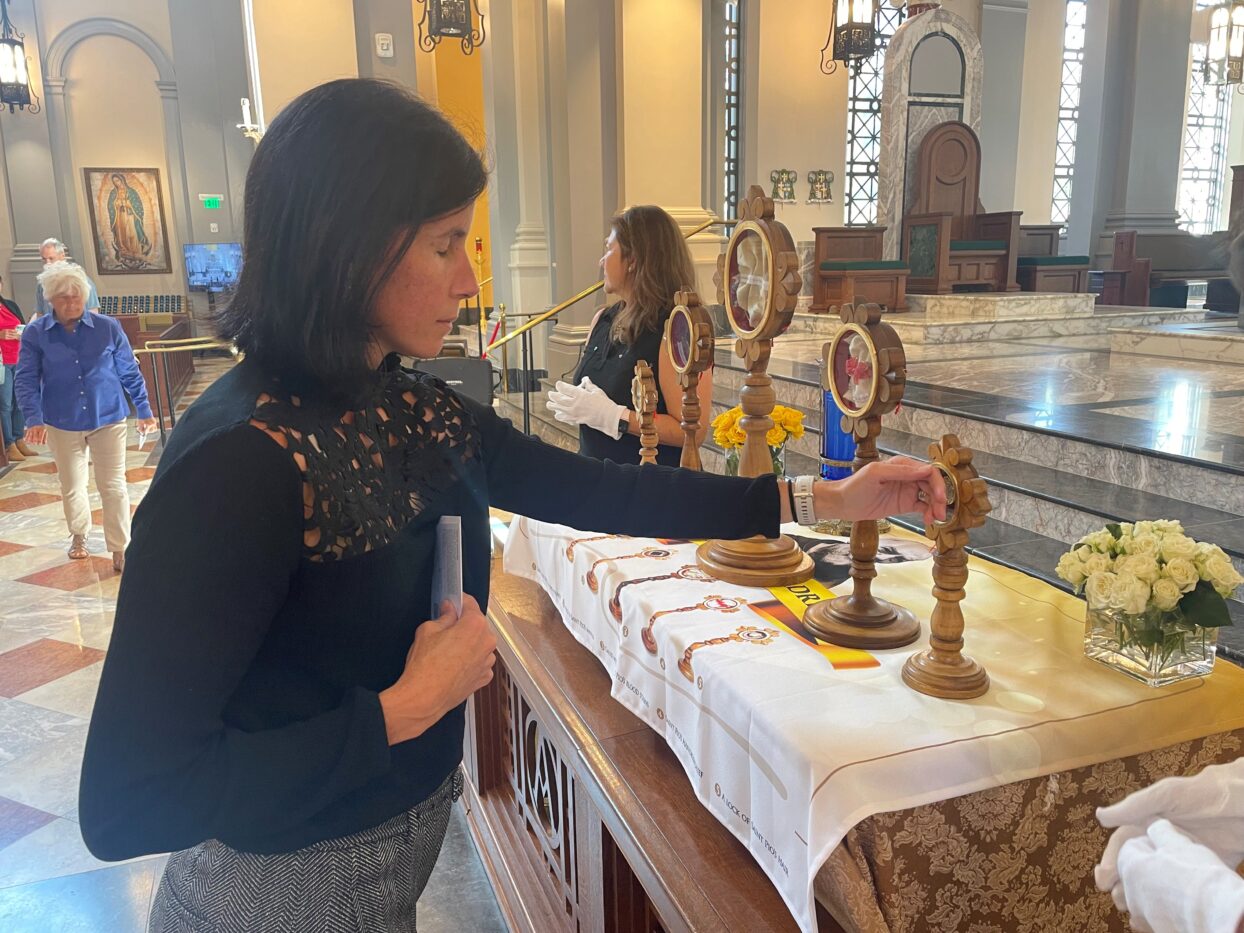Faithful from East Tennessee and beyond venerate beloved Italian saint
By Dan McWilliams
Hundreds of the faithful venerated the relics of St. Pio of Pietrelcina on Sept. 26 and 27 as they were exposed first at the Cathedral of the Most Sacred Heart of Jesus in Knoxville and then the next day at the Basilica of Sts. Peter and Paul in Chattanooga.

A line of faithful forms inside the Basilica of Sts. Peter and Paul in Chattanooga to venerate the relics of St. Pio, which were on display on Sept. 27.
The beloved Italian saint, more popularly known as Padre Pio, was a Capuchin friar who lived from 1887 to 1968. He is known for his devotion to long hours of prayer, a profound acceptance of suffering, and the intense scrutiny he faced from Church authorities for claims of bilocation, receiving the stigmata, and other mystical experiences.
Richard Ruyack, a representative of the St. Pio Foundation, attended the exposition of relics at the cathedral and basilica. The foundation is dedicated to the promotion of the spiritual legacy of Padre Pio and sponsors a worldwide tour of the relics. The St. Pio Foundation offered personalized devotional items for purchase by those visiting the relics at both churches.
“This tour has been going on for three years now, and we’ve been all across the country and in other countries also,” Mr. Ruyack said.
The response to the tour “has been incredible,” he added.
The tour allows those who can’t make a pilgrimage to Padre Pio sites in San Giovanni Rotundo, Italy, where the intact body of the saint lies in the St. Padre Pio Shrine, to venerate the relics. The shrine receives about 6 million visitors a year.
“People come out from everywhere” on the tour, Mr. Ruyack said. “They feel solace and a sense of well-being once they do come and venerate. We’re a not-for-profit charitable organization, where we have other works beside the relics tour, but our main function as the Pio Foundation is to bring the relics of St. Padre Pio to people who would never have a chance to travel to Italy and go to see where he was born and raised and his tomb.”
Padre Pio received the stigmata—the wounds of Christ on the cross—in 1918. The five relics that appeared at the cathedral and the basilica included a crust from one of his hands that came from the stigmata. The other four relics were a lock of the saint’s hair, a handkerchief soaked with his sweat only hours before he died, a piece of his mantle, and a cotton gauze with his bloodstains. The handkerchief and the piece of the mantle appeared only in certain archdioceses and dioceses on the tour.
Catholics visiting the relics in East Tennessee touched rosaries and other objects to the relics.
“If you have a relic, any type of religious article, and you touch it to this relic, it becomes a third-class relic,” Mr. Ruyack said.

A parishioner touches her hand to a Padre Pio relic of a gauze with the saint’s bloodstains at the Cathedral of the Most Sacred Heart of Jesus on Sept. 26.
Padre Pio’s Italian heritage is part of what makes him perhaps the most popular saint for Catholic devotions, but “also he was alive when many of us were alive, and that seems to be for me what makes it kind of special, that he was on this earth while we were here,” Mr. Ruyack said.
The relics were exposed at the cathedral from 9 a.m. to 8 p.m., with Mass at noon. The regular noon Mass was celebrated at the basilica, and the relics were exposed afterward from 12:30 to 7 p.m. The relics of Padre Pio first toured the United States in 2017. Knoxville and Chattanooga are two of nearly 30 U.S. cities to host the relics this year.
Jennifer George of Holy Ghost Parish in Knoxville, who came into the Church about four years ago, was among the many venerating Padre Pio’s relics at Sacred Heart.
“I’m just overwhelmed. I’m shaking, but I’m so grateful. It’s just awesome—Padre Pio was something else,” she said.
Padre Pio “was a wonderful man, and I think he had a great sense of humor,” Ms. George said. “He went through a lot of troubles. He just kept on and on. I just think he was definitely a man of God.”
Cyndy Leard of St. Thomas the Apostle Parish in Lenoir City also visited the cathedral to see the relics.
“I think it’s a once-in-a-life time opportunity and a very holy and blessed experience,” she said.
Ms. Leard said she “touched my Sacred Heart medals and my scapular medal” to the relics of Padre Pio.
“He’s just a man of the people, and people can relate to him,” she said.
Father David Boettner, rector of the cathedral, celebrated the noon Mass with the relics exposed to the left of the altar steps. Concelebrating were cathedral associate pastor Father Martin Gladysz and two guest priests: Father Tomasz Szopa, rector of the St. John Paul II Shrine in Krakow, Poland, and Father Dustin Collins, pastor of St. Mary Parish in Johnson City.
“What a blessing it is to be able to gather together to pray in the presence of the relics of Padre Pio,” Father Boettner said in his opening remarks. “It’s good to be together. As we begin this Mass, I just invite you to call to mind the people you brought with you, not the ones standing next to you but the ones who are on your heart: the people you are praying for, the people you are thinking about, especially those who are struggling, those who are ill, maybe those who are alone. Bring all of those people to this celebration so that we might also draw them close in the Father’s love and recognize our role as intercessors.”
In Father Boettner’s homily, he talked about two temples and two families. The first temple is the house Catholics worship in, while the second is their bodies, which are the temples of the Holy Spirit.
The COVID pandemic led to churches suspending Mass temporarily as the faithful received Communion spiritually if not physically, he said.

Deacon Renzo Alvarado Suarez, who is serving at the basilica, gives a reflection on St. Pio of Pietrelcina to the basilica’s Hispanic community in Varallo Parish Hall on Sept. 27.
“We knew the difference, right? We knew what we were missing,” Father Boettner said. “We knew what wasn’t occurring because we weren’t able to physically receive the Lord into our bodies. That’s an important reminder to us that we are not just spiritual people. We are not just disembodied spirits wandering around the earth. We are bodily people, and that’s why we believe in a bodily resurrection. That’s why God cares about the temple of our bodies. That’s why those healings, those miraculous cures, that are associated with Padre Pio and other saints are important signs to us. It’s not just that somebody got lucky and got a miracle. They’re signs, and they’re signs of the importance of us as tangible realities and that God is concerned about us as a whole person. That’s one temple.”
The two families are the biological families Catholics are born into and “a secondary blessing: our family of choice, which includes our church family,” Father Boettner said.
“Because we belong to the human family and the family of God, we can make intercession through the saints, and they are part of our family as well,” he said. “The wonderful thing about being Catholic is we have this whole host of saints who we can learn about, who we can befriend, who we can seek their intercession, and that they have a role to play in our lives. They pray for us. They pray for us because they love us, and they love us because they see in us what God sees in us. They see the creation of God, the image and likeness of God. So today we have this special opportunity to pray with and through the intercession of Padre Pio, and his intercessions are still very effective.
“It would be the same thing—if I wanted to ask Father Dustin to pray for me, which I do, I know Father Dustin will pray for me. He’s a man of prayer, and if I asked him to pray for something specific, he would do that, too, because he’s a man of prayer. The same is true of Padre Pio. Padre Pio is a man of prayer. Even though he’s united with God in heaven, he still prays for us. I invite you today to take that opportunity to ask Padre Pio to pray for whatever need you may have. Be as specific as you can be. Be as bold as you can be. Be as full of hope as you can be because God desires our good. God desires to save us. God desires the ultimate good for us: to draw us close to Himself so that we might be happy with Him forever in heaven. Today, pray—pray through the intercession of Padre Pio. Pray for your brothers and sisters in the family of God, and pray that God might not only hear and respond to our needs but that we might become more aware of those in need of our prayers.”
Father Boettner spoke after Mass as a line of the faithful stretched from the relics in the front of the cathedral to the back doors.
“As you can see, it’s really drawn a lot of people together. I talked to some folks from Ohio, some from North Carolina, some from Crossville, some from Knoxville. It just drew a lot of people together who wanted to pray through the intercession of Padre Pio,” he said. “At the beginning of Mass, I mentioned all the people we brought with us, not physically, but so many of us have people on our hearts who we’re praying for, people who are going through serious illness, depression, or job loss, all these different needs. Padre Pio was such a beautiful intercessor and a gift to the Church. I’m just thrilled that we can have this today and draw people together in prayer.”
Padre Pio’s popularity may be due to the fact that “he’s relatable to people,” Father Boettner said.
“So many people who came back from World War II brought stories of Padre Pio with them, and that devotion to Padre Pio really spread throughout the United States with all those U.S. soldiers coming home. It seems like it’s really remained strong—people still identify very much with Padre Pio,” he said.

Father Michael Hendershott, associate pastor of Holy Ghost Parish in Knoxville, leads a reflection on the life and sainthood of Father Pio of Pietrelcina, more commonly known as Padre Pio. The reflection was given in Varallo Parish Hall in the Basilica of Sts. Peter and Paul in Chattanooga, where the relics of Padre Pio were displayed on Sept. 27.
In the basilica’s Varallo Parish Hall, Father Michael Hendershott, associate pastor of Holy Ghost Parish, gave a reflection in English on Padre Pio, and Deacon Renzo Alvarado Suarez offered a reflection in Spanish. A multilingual Mass in honor of Padre Pio was celebrated at 7 p.m. in the basilica.
“Padre Pio is a reminder that God is still at work in the world,” said Father David Carter, rector of the basilica. “He is still calling men and women to holiness every day. He assists us through the examples of saints like Padre Pio. God also shows His care for us by answering our prayer and working miracles through the intercession of great saints such as Padre Pio.”
A relic of a saint “is what remains of the earthly body of a person whose soul is now enjoying the beatific vision of God Himself,” Father Carter said.
“As a human being, we are composed of body and soul. At death these are separated. But we know that on the last day the body and soul will be reunited through the resurrection of the body. That is why we hold these bodily remains (relics) in such veneration. These are the bodies that will share in the resurrection of the just and stand in the presence of God almighty. To have the relics of a saint as well-known and as powerful in intercession and working miracles has caused many people’s hearts to move closer to God. The closer we get to saints, with whom we can relate as human beings, the closer we get to God, with whom that saint is now joined in heaven. This is a part of the mystery of belonging to the body of Christ and the communion of saints,” he noted.
As did the cathedral, the basilica “had a steady stream of visitors and people from all over who came to venerate the relics of Padre Pio. It perhaps wasn’t as large a number as at the cathedral the previous day, but we counted the number in hundreds,” Father Carter said.
“We had people from all over the Chattanooga area for sure, but even people from as far away as Nashville, Atlanta, and Birmingham took advantage of the visit of these relics to the basilica. It was a great way to gather together many who otherwise would be spread out over large distances. By all of these people coming together in devotion, the body of Christ and the communion of the saints was made manifest. This was especially true at the Mass we offered at the close,” Father Carter continued.
“We had people from many diverse communities at one liturgy. To respond to this diversity, we expressed the universality of our Catholic faith by having Mass in multiple languages. The readings and the parts for the people were prayed in English and Spanish, and the Canon of the Mass and the sung ordinary were prayed in the Latin language common to all Roman Catholics. Singing the Sanctus and the Agnus Dei together with one voice, we were able to manifest the unity of faith that is our sacred heritage, which includes Padre Pio and the many holy men and women who prayed in this universal language throughout the history of the Roman Catholic Church. We also sang the Kyrie in Greek as a nod to our Eastern brothers and sisters who shared the faith with the early church in Rome,” he concluded.

